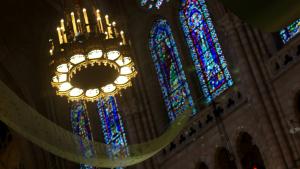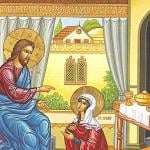Welcome back to the sanctuary this morning. We’ve been out for most of the summer and it feels good to be back, doesn’t it? Today we begin a series in worship where we’re looking at the Israelites’ prayer book, the Psalms, and reimagining some of the thing we take for granted in our life together as the church. Today we’re talking about sanctuary.
Recently, after picking up a copy of Budget Traveler magazine and reading an article about interesting weekend getaways, I took a few days to go and explore Lancaster, Pennsylvania. Lancaster, as you know, is central to Amish country, and there are a lot of quaint shops and art galleries there, in addition to horses and buggies and all that Amish stuff, to explore.
I am not one to stick to conventional advice, however, and in addition to the article I read, I did a little bit of research of my own. Thank goodness I did, because had I not I would not have read about the Biblical Tabernacle Reproduction, located at the Mennonite Visitor’s Center in Lancaster. The website claims, “Many people of different religious, ethnic and cultural backgrounds find this lecture tour of the Biblical tabernacle reproduction the high point of their visit to LancasterCounty.” Well, how could I possibly miss that?
I have traveled in many places all over the world and visited vast cathedrals, incense-thick temples, and one room rural churches. I have never, however, encountered anything quite like the Biblical Tabernacle Reproduction, which is exactly what its name says it is. And while this might seem like a joke as I am telling it now, I discovered when I met our impassioned tour guide, that for those who run the Biblical Tabernacle Reproduction (and for many of the people on my tour that day), it is most assuredly not a joke.
For an entry fee of $7.50 ($5.00 for students and seniors) you can take a 40-minute guided tour of an exact replica of the Israelite Tabernacle, the portable dwelling place of God in ancient Israel, as described in excruciating detail in several chapters of the book of Exodus. On the tour you will learn that the Biblical Tabernacle Reproduction was first thought up by a Baptist (of course), who preserved the exhibit exactly as the original was as a tool for students “of the Bible and of cultural studies.”
The Tabernacle goes, as it did when the Israelites carried it around the desert for 40 years, from the outside courtyard to the Ark of the Covenant and into the Holy of Holies (which you can’t go into but you can see through a glass observation window). All the fabrics and furniture are carefully created as exact replicas, each one researched at great length
I think the highlight of the Biblical Tabernacle Reproduction has to be the wax figure of the high priest that is installed on an automatic track. When tour groups come into the central area of the Tabernacle, the tour guide presses a button and the high priest jerkily slides along the track, demonstrating how sacrifices were offered.
The goal of this display, it seemed to me, was to create an exact replica, to keep the sanctuary of the Israelites exactly as it was thousands of years ago, to have something tangible and unchanging to remind us of God.
The ancient Israelites, in fact, carted around the tabernacle for years and years, all through their exile in the desert and even after they came into the Promised Land. And creating a static, unchanging edifice to hold God became even more important then. King David, the most famous king of Israel, wanted desperately to build God a permanent house. He never did, but his son Solomon built a glorious house on the temple mount in Jerusalem, a sanctuary for the living God.
There’s something in us that wants so very desperately to create tangible, unchanging edifices, sanctuaries, places where we come face to face with God, where we remember who we are in the light of God’s work in the world, and where we find solace and comfort.
We know this, if for no other reason than because of the beautiful Psalm we have heard over and over in our worship today. It’s Psalm 84, and it’s a poem composed after the building of the temple. In it, as you have heard, there is a general longing for the house of the Lord, the voicing of a deep need for sanctuary, a holy place away from the harsh realities of life. And this song is a song for anybody who finds herself on a pilgrimage toward the sacred.
You’ll note there are three movements in this Psalm. The first is an expression by those who live and work in the house of the Lord. Scholars suggest that it was actually people in the choir about whom this first movement was written…”Happy are those who live in your house, ever singing your praises!” Even those who are in the sanctuary day in and day out extol the praises of God and the gift of sanctuary.
A second part of the Psalm talks about those who are on their way to the house of the Lord…in the process of searching out sanctuary. They go through the valley of Baca, the text says, a valley of a dry and parched life, and as they move toward sanctuary they find springs—pools of water springing up all around them. Nourishment. These are the people on the way to sanctuary—they know they need to be in the house of God, and they are making their way in that direction, through all the pain and distance that life brings us.
A third stanza in this song speaks of those who are very far off. Perhaps they are having trouble finding a place of sanctuary in their lives; perhaps the house of God is not a place they often go. But even from far off they are longing for sanctuary, too. “Even a day in your courts is better than a thousand elsewhere!”
No matter which category you fall into, just like the Israelites who sang this beautiful Psalm so long ago, we long for tangible expressions of God, for sanctuary. It’s understandable, really. We want to put walls around the mystery of the divine, to contain in a static expression everything we know and experience of God. But the truth of the matter is that when we create sanctuaries, we cannot, no matter how hard we try, contain God in a static, never changing place. Sanctuary is always evolving, because sanctuaries are built and stand as testimonies to a truth that is far bigger: that God is here, living with us in relationship, expressing in new and wonderful ways all the hopes God has for our world. We can encounter God in sanctuary, but God cannot be contained in any building we create. When we long for sanctuary, the house of the Lord, we are really longing…for God.
It’s curious to hear the song of the Israelites on this Sunday, the Sunday that we return from our summer worship in the chapel, to this amazing room we call the sanctuary. We have longed for the sanctuary this summer (some of us more than others), and just like the Israelites’ story of sanctuary, our sanctuary has a story, too.
In 1863, the Union army had just won a critical victory at Gettysburg. Up until that point in the Civil War, nobody had been sure about the safety or even the future of the Capital city. With this victory, things began to change. Calvary was a little group of folks who had been worshipping together and had recently celebrated the official founding of the church (a ceremony that took place down the street at NY Ave Presbyterian church). Like King David, trustees of Calvary wanted to build an incredible building, a static, permanent place that would serve as a sanctuary where people could come and encounter God. And so, they did.
But, as elegant and historic and old as it is, there’s nothing much that static in this sanctuary; there’s been a lot of change since this place was first dreamed up. For one thing, it burned to the ground in 1867. Its once gas-lit rooms are now wired with electricity. In the 1920s someone thought it would be a good idea to add a balcony to get the seating capacity of this room up to about 800. Around then, all new pews were installed. At some point in its history, the jack which raised and lowered the pulpit (not kidding) was removed. The organ was installed, then expanded, then rebuilt, then changed repeatedly. Most recently, in the early nineties, a massive renovation of the space took place.
All of these things have changed and continue to change, reflecting the life of a community following God. And they are changing now. Here we are, stewards and caretakers of this beautiful house of God. It’s changing even here with us…who knew we’d have simultaneous translation in this sanctuary? Who could have guessed that our grand organ would be played by talented young students? Who imagined that we wouldn’t serve communion with long white gloves anymore, and that our children would feel welcomed to come right up to the front and touch the altar?
As much as we humans are on a pilgrimage to find sanctuary, an expression of God that never changes, the truth is that sanctuary should always be changing. It is not our job to preserve it as a dusty old edifice in memory of days gone by. Because sanctuary is not static; only God stays the same. Whether it’s gas lit or electrically wired, whether you can raise the pastor in the pulpit or not, whether all the pipes on the organ are current working…the one thing that remains is that this has been and can be a place to encounter God.
Sanctuary for folks trying to be the church.
Sanctuary for those who are left out or kicked out of other places.
Sanctuary for our children.
Sanctuary for the hopes of the future and, most of all, for those of us who seek an encounter with God.
And sanctuary points us to the truth that God is with us ever and always in this ever-changing adventure called human life.
Sanctuary. We love it; we love what it stands for. But after almost 150 years of standing on this corner, the bricks and mortar that have held it up all this time are getting a bit crumbly. We are faced, again, with the question, not of why we would maintain such a space, but rather how. How can we use this sanctuary to serve the needs of our community as they stand now? What changes do we need to make to make this place more accessible and more usable for everyone who is seeking God? In what new ways can we imagine this place a sanctuary for anyone seeking God?
In short: how can we offer sanctuary…a place where God is and a reminder of God’s presence in the world…for as many people as we possibly can?
Church, we have been entrusted with this beautiful sanctuary. It is a place where we encounter God, but it is so much more than that. This place is a symbol of God’s active presence here with us. And that is a reminder our whole world so desperately needs. As we reimagine what our sanctuary can be for this community and this world at this time, we can hear the echoes of Psalm 84 in our minds: our souls long for a place, for this place, to come and to remember that God is always with us.
Sanctuaries change; they must be reimagined. But one thing never changes. I remembered that on my Lancaster tour, when our guide, an elderly woman, led us faithfully through the entire exhibition. At the end of her tour, in the middle of the tabernacle courtyard, the elderly guide startled us all by stretching her arm out dramatically and yelling, “Behold!”
All of those among us who were making less than respectful comments under our breaths stopped and suddenly paid attention.
“Behold!,” she said again…”the dwelling of God is among us!”
Indeed.
The dwelling of God is among us. In this sacred space and in all the spaces we encounter a living, active, engaged God. We must re-imagine sanctuary, our sanctuary, because we believe: the dwelling of God is among and within us. Thanks be to God. Amen.











